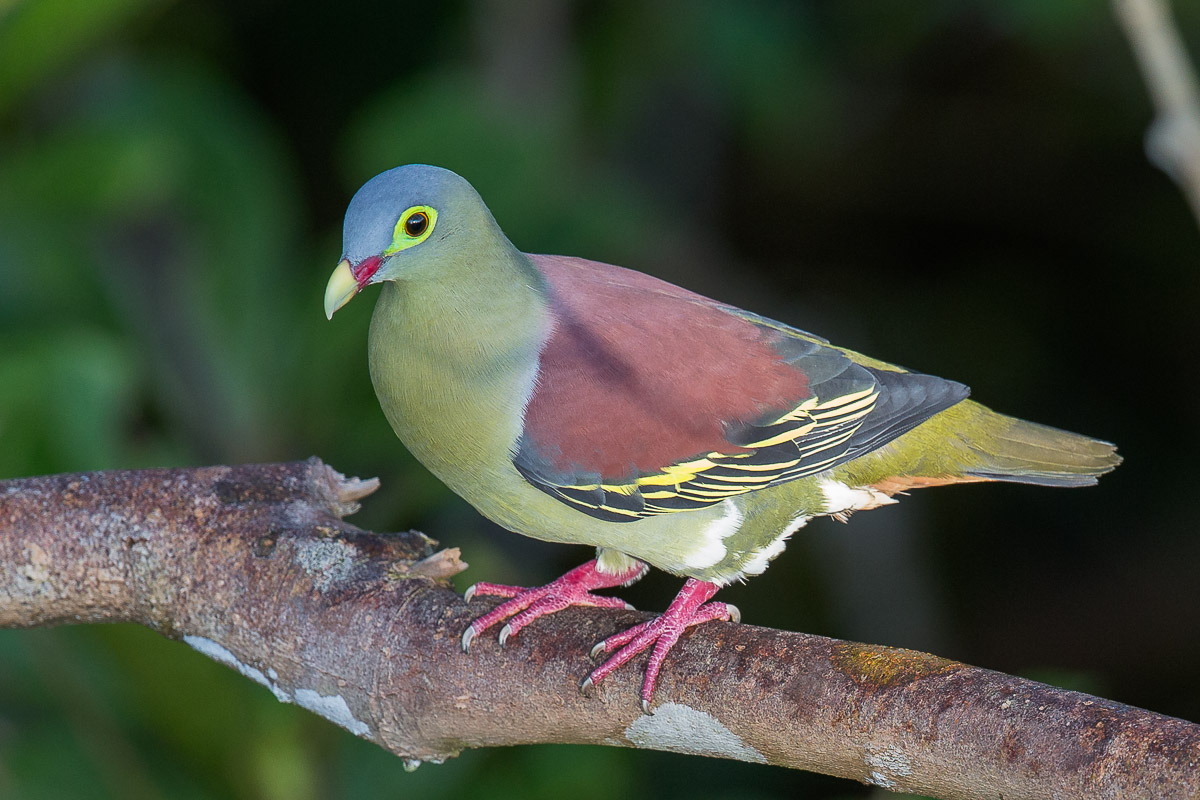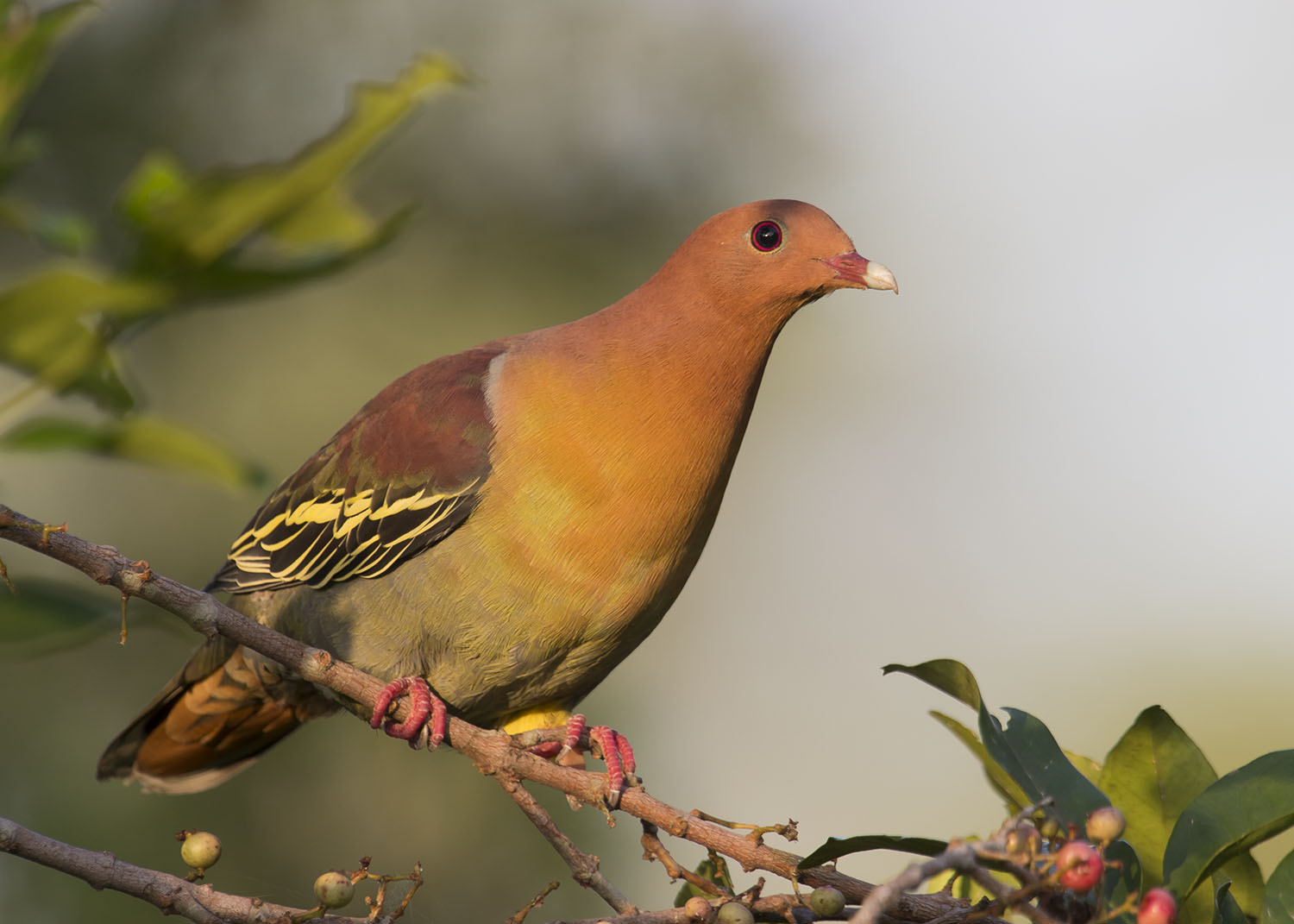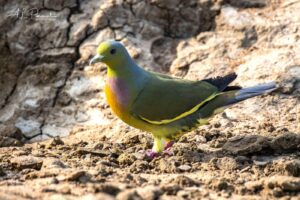Written by Yip Jen Wei with input from the Singapore Birds Records Committee
Editing by Keita Sin, Dillen Ng, Raghav Narayanswamy, Sandra Chia, & Geraldine Lee
In October 2021 a series of national firsts made landfall in Singapore in quick succession, the first of which was a male Ashy-headed Green Pigeon Treron phayrei. But unlike most of the others, there is considerably more uncertainty to the origin of this pigeon: is it an escapee or not?
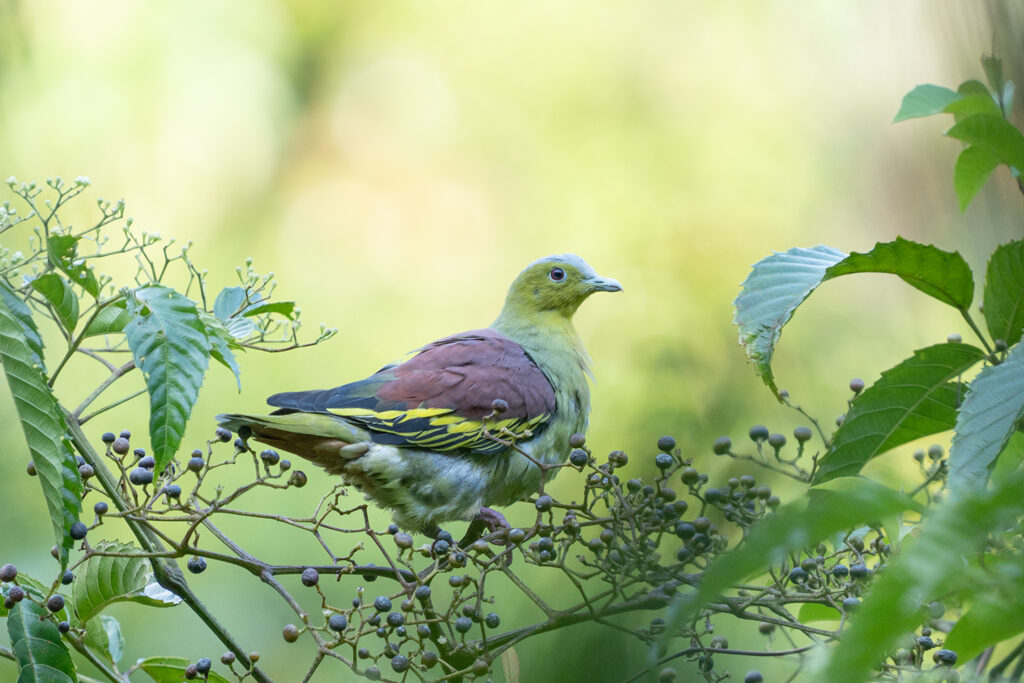
To start off, there is little uncertainty regarding the identity of this pigeon. The bird is green, with a maroon mantle and wings, a yellow rump, yellow edges to dark flight feathers, chestnut undertail coverts, and a grey forehead. Going by the overall green colour and the fully developed maroon on wings, we can start from a male of the genus Treron, commonly known as green pigeons. Shown below is an image from the original sighting on 9 October 2021 as well as a list of Treron pigeons in Singapore and the field marks that rule them out:
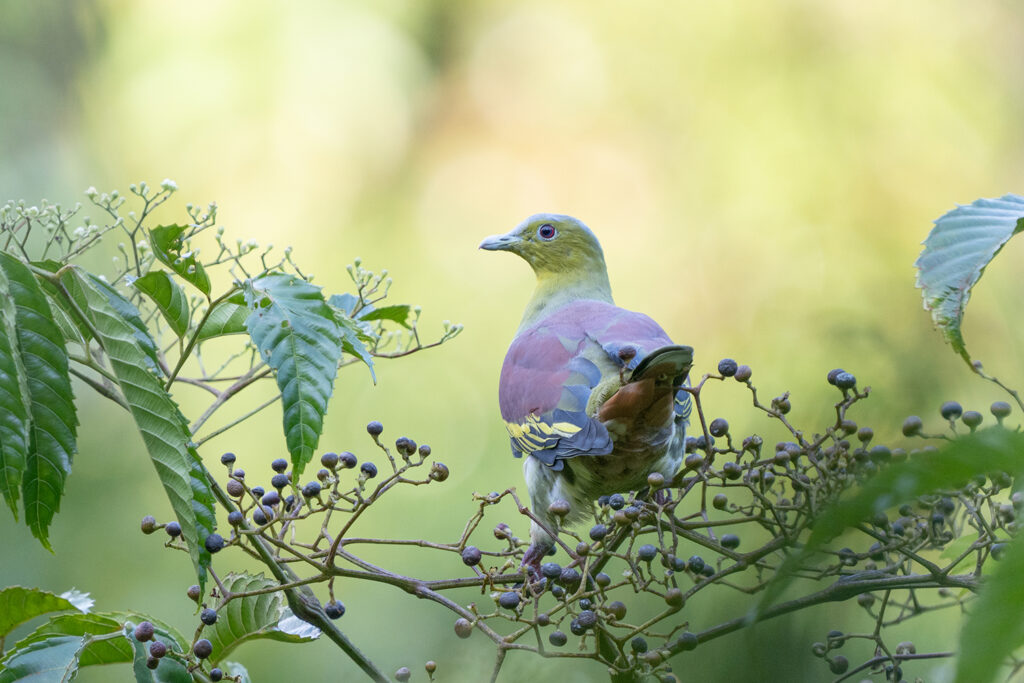
| Pink-necked Green Pigeon
T. vernans |
Male has pink neck, green wings |
|
| Thick-billed Green Pigeon
T. curvirostra |
Male has fleshy orbital ring, thick bill, and bulge to cere |
|
| Cinnamon-headed Green Pigeon
T. fulvicollis |
Male has orange head |
|
| Little Green Pigeon
T. olax |
Male has grey head and white iris |
|
| Orange-breasted Green Pigeon
T. bicinctus |
Male has green wings and prominent orange and pink on breast |
|
Having ruled out all known local species we can look at species beyond our shores. Visually, the only two possible matches are Ashy-headed and Grey-fronted Green Pigeon T. affinis. To rule out Grey-fronted Green Pigeon, we can look at the clear delineation of the grey crown, as well as the orange patch on the breast which is absent in T. affinis.
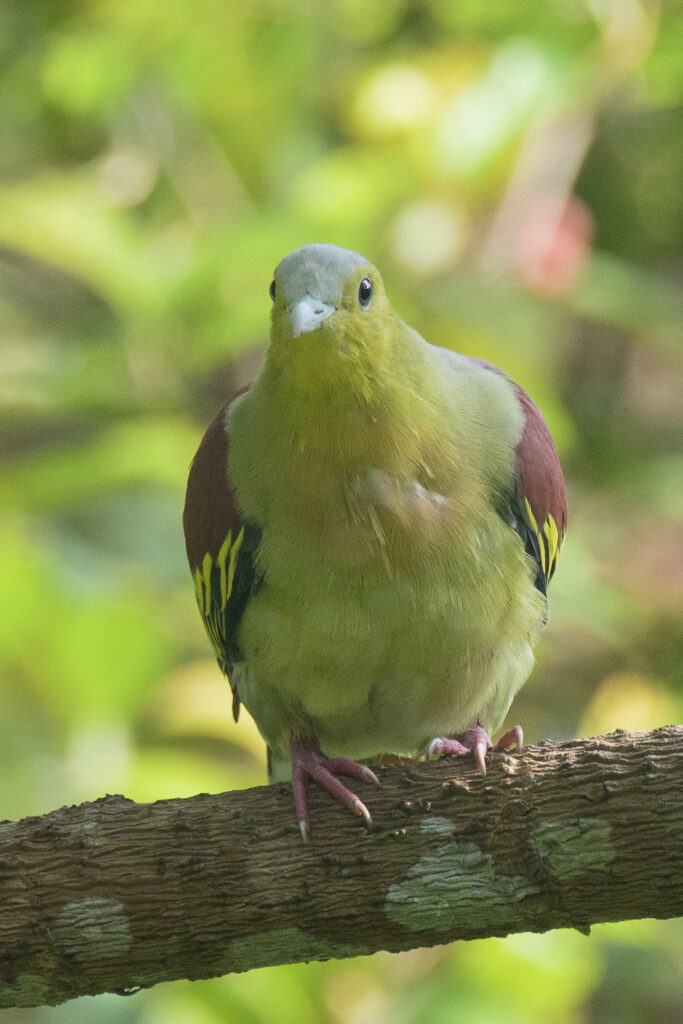
Now that we are certain of the identification, we are faced with the monumental task of figuring out its origin. Listed below are some of the factors that were considered when determining if this bird is a genuine vagrant or if it has origins in the pet trade:
-
- Is this bird or related species known to migrate or travel long distances?
- Is the species common in the pet trade, legally or illegally?
- Is the bird in good condition?
- Are there any similar cases of vagrancy?
First off, are Treron pigeons known to migrate or travel long distances? The short answer is that no, Treron pigeons do not typically undertake seasonal migration (Birdlife International, 2021), but pigeons are good dispersers and have been known to travel long distances in search of food. Similar species such as Thick-billed Green Pigeon have been recorded undergoing mass dispersal for fruit, along with small numbers of Yellow-vented Green Pigeon T. seimundi. In particular, night dispersal of Thick-billed Green Pigeons occur year-round, but peak in October-November (Wells, 1999)—incidentally this sighting of Ashy-headed Green Pigeon falls under the same timeframe. There are also hints of regular movement for Cinnamon-headed Green Pigeon to Pulau Ubin: in addition to sightings at other parts of the year, from 2018 to 2021 the species has been annual for the first week of December at the same fruiting trees in Western Ubin.
Secondly we look at the prevalence of Ashy-headed Green Pigeons or other Treron species in captivity. To answer the easiest question first: no, this species is not found in Jurong Bird Park or Mandai Wildlife Reserves. In recent published surveys from Vietnam, Thailand, Singapore, and Java, Ashy-headed Green Pigeon is also not listed as a legally or illegally traded species (Chng et al, 2015; Chng & Eaton, 2016; Eaton, Leupen, & Krishnasamy 2017; Eaton, Nguyen, et al., 2017; Phassaraudomsak & Krishnasamy, 2018). However, Treron species like Pink-necked and Thick-billed Green Pigeons have been recorded in these surveys, so it is still not beyond the realm of possibility that small numbers of Ashy-headed Green Pigeons are in the black market having avoided detection.
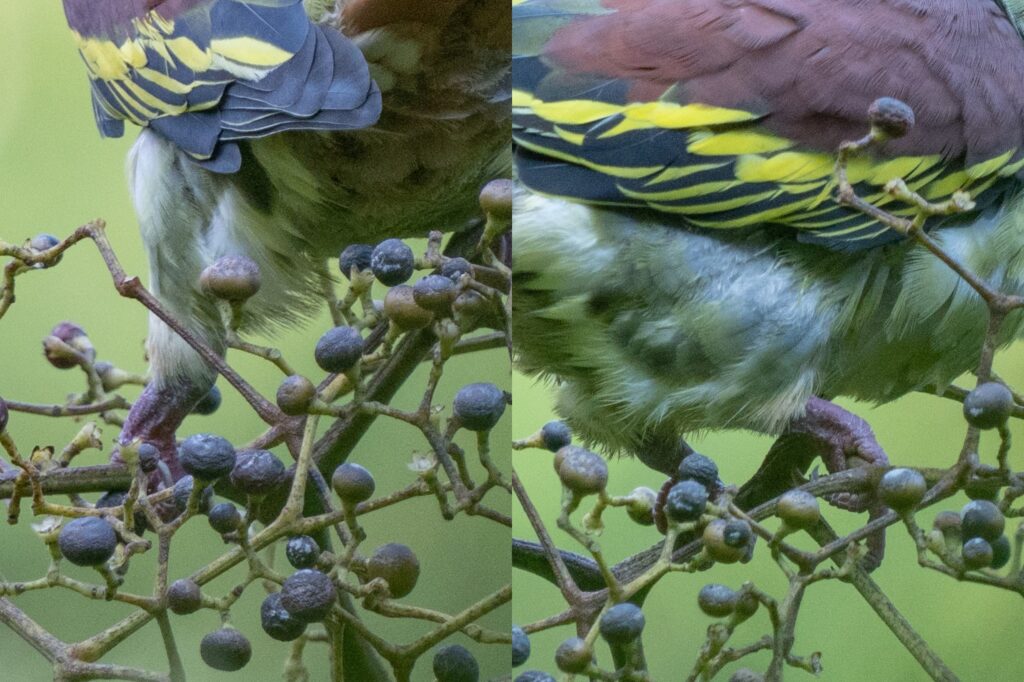
Thirdly, poor condition of the bird’s plumage is often cited as an indicator that the bird was once in captivity. In this bird’s case, this is not an issue: the bird is in pristine condition, from the above image there are no rings on its legs, its nails are not clipped, and its feathers are not tattered. The physical condition of the bird offers no indication that the bird was a recent escape from captivity.
It is also helpful to compare this sighting with other cases of natural vagrancy with similar characteristics: closely related species, or species with comparable ranges and movement patterns.
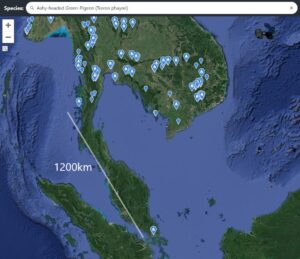
Here is an eBird range map for Ashy-headed Green Pigeon in the region. We can see that there are no records in Malaysia and the nearest record is in Southern Thailand, around 1200km away.
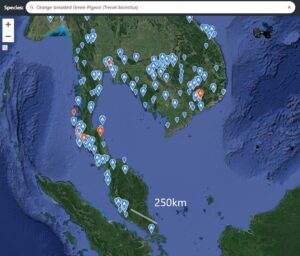
The most immediately obvious comparison is Orange-breasted Green Pigeon, another vagrant Treron with similarly only one record to Singapore from 2007 (Bird Ecology Study Group, 2008). However, this species is present in Peninsular Malaysia, with the nearest record being Port Dickson, around 250km away.
Between these two cases of Ashy-headed and Orange-breasted Green Pigeon vagrancy to Singapore, both exhibit long distance dispersal, but Ashy-headed is far more extreme. We go on to see if there are any similar cases of natural vagrancy to Singapore in the range of 1200km.
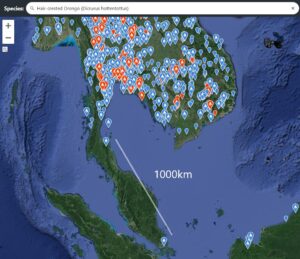
This is a range map for another species with only one record in Singapore: Hair-crested Drongo Dicrurus hottentottus. Distance-wise, its nearest records and even native range are comparable to Ashy-headed Green Pigeon. However, Hair-crested Drongo is a known long distance migrant (Birdlife International, 2021) while Treron pigeons are not. An Ashy-headed Green Pigeon’s natural dispersal is far more surprising than a Hair-crested Drongo’s migration to Singapore for the same distance. So while it is not accurate to compare one to the other, it does show that absence of a species in Peninsular Malaysia should not completely discount any case of potential vagrancy to Singapore. The fact that both these (and other) species have escaped detection on their journey south from Thailand along the Malaysian Peninsula is also not terribly unusual. Given our incredibly high observer density and position at the southernmost point of Continental Asia, Singapore has a unique advantage in detecting stray vagrants, as our stellar migration season can confirm.
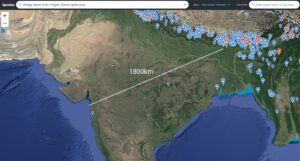
Finally, here is a range map for Wedge-tailed Green Pigeon Treron sphenurus. Lone records in the centre and the western coast of the Indian Subcontinent represent extreme cases of just how wildly out of range Treron pigeons can sometimes show up at, with distances from the core range far exceeding our case of Ashy-headed Green Pigeon.
These are just some examples to show that it is not inconceivable for an Ashy-headed Green Pigeon to fly 1200km from Southern Thailand to Singapore in an interesting case of natural dispersal or vagrancy. Indeed, as with the Wedge-tailed Green Pigeon, more extreme cases of Treron dispersal have occurred.
The Singapore Birds Records Committee has placed this record in Category A (natural vagrancy) through a majority vote of 6-2. To sum things up—in making this decision, the committee considered the following:
-
- Ashy-headed Green Pigeon is absent from local captivity and recent surveys of traded species around the region.
- Treron species are capable of making such long distance flights.
- Plumage and condition of the bird offer no indication the bird is an escapee.
- Date and location (Central Catchment Nature Reserve) of sighting are supporting factors for the bird being a genuine vagrant.
- Lack of records in Malaysia is not unusual given Singapore’s high observer density and the fact that other species have also escaped detection to Malaysia.
Of course, unless we learn to speak Pigeonese, we will never know the true origin of this bird. This offers us some interesting food for thought—what are some indicators that would reaffirm the committee’s decision or skew it toward being an escapee?
For starters, if an Ashy-headed Green Pigeon were to turn up caged or ringed somewhere in Singapore or Malaysia where it is not known to occur, that would be definitive proof that they are traded (legally or illegally) and might swing the vote against the current decision. On the other hand, if more Ashy-headed Green Pigeons or species with similar ranges and habits were to turn up nearby, it would be much harder to discount two separate sightings as repeated incidents of escapees of a bird not known to be on the market.
As with most national firsts of contentious origin, we may never have a definitive answer regarding the provenance of the bird, by nature of it being a national first record—there just isn’t enough information. At present, the best we can do is make an educated guess.
References
Birdlife International. (2021). Ashy-headed Green Pigeon Treron phayrei. Birdlife Datazone. http://datazone.birdlife.org/species/factsheet/ashy-headed-green-pigeon-treron-phayrei/details
Birdlife International. (2021). Hair-crested Drongo Dicrurus hottentottus. Birdlife Datazone. http://datazone.birdlife.org/species/factsheet/hair-crested-drongo-dicrurus-hottentottus/details
Chng, S. C. L. & Eaton, J. A. (2016). In the Market for Extinction: Eastern and Central Java. TRAFFIC. Retrieved December 22, 2021, from https://www.traffic.org/site/assets/files/2393/in-the-market-for-extinction.pdf
Chng, S. C. L., Eaton, J. A., Krishnasamy, K., Shepherd, C. R., & Nijman, V. (2015). In the Market for Extinction: An inventory of Jakarta’s bird markets. TRAFFIC. Retrieved December 22, 2021, from https://www.traffic.org/site/assets/files/2466/market_for_extinction_jakarta.pdf
Eaton, J. A., Leupen, B. T. C., & Krishnasamy, K. (2017). Songsters of Singapore: An Overview of the Bird Species in Singapore Pet Shops. TRAFFIC. Retrieved December 22, 2021, from https://www.traffic.org/site/assets/files/2278/songsters-of-singapore.pdf
Eaton, J. A., Nguyen, M. D. T., Willemsen, M., Lee, J., & Chng, S. C. L. (2017). Caged in the city: An inventory of birds for sale in Ha Noi and Ho Chi Minh City, Viet Nam. TRAFFIC. Retrieved December 22, 2021, from https://www.traffic.org/site/assets/files/1580/caged-in-the-city.pdf
eBird. (2021). Ashy-headed Green Pigeon range [Screenshot]. https://ebird.org/map/pomgrp5
eBird. (2021). Hair-crested Drongo range [Screenshot]. https://ebird.org/map/hacdro1
eBird. (2021). Orange-breasted Green Pigeon range [Screenshot]. https://ebird.org/map/orbpig1
eBird. (2021). Wedge-tailed Green Pigeon range [Screenshot]. https://ebird.org/map/wetpig1
Low, A. & Cheah, W. K. J. (2008). Orange-breasted Green Pigeon sighted in Jurong. Bird Ecology Study Group. https://besgroup.org/2008/01/12/orange-breasted-green-pigeon-sighted-in-jurong/
Phassaraudomsak, M. & Krishnasamy, K. (2018). Trading Faces: A rapid assessment on the use of Facebook to trade in wildlife in Thailand. TRAFFIC. Retrieved December 22, 2021, from https://www.traffic.org/site/assets/files/11073/trading_faces_thailand_2019.pdf
Wells, D. (1999). Birds of Thai-Malay Peninsula. Academic Press.



